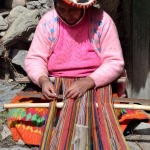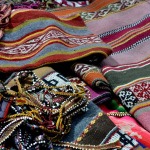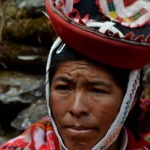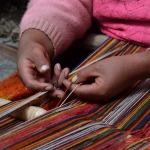Incas Design Goes Modern
Story & photos
by Andrea Rodulfo
One of the most important cultures of the pre-Columbian America was the Inca, whose center was situated in Cusco, Peru. On my travels through South America, getting to know, in person, this culture was a must, so we drove our Volkswagen from Ecuador to Peru and immediately started experiencing a completely unique culture.
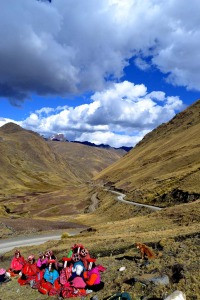 Even though the Imperial Age is far gone, nowadays 70% of Peru‘s population are descendants of the Incas and a vast part of their traditions have been preserved by the indigenous communities that inhabit all along the country, whose lives have changed very little since the time of the Inca Empire.
Even though the Imperial Age is far gone, nowadays 70% of Peru‘s population are descendants of the Incas and a vast part of their traditions have been preserved by the indigenous communities that inhabit all along the country, whose lives have changed very little since the time of the Inca Empire.
When you are near the Andean mountain range it is easy to spot women wearing their traditional clothing, handmade by themselves. These clothes play a very important role in Andean communities since they are distinctive signs of their history, who they are and where they come from. Besides that, their styling also helps them go through their daily duties: wrapping their babies on their backs or carrying their purchases the same way.
I wanted to know more about the beautiful textiles they wore: colorful handmade pieces, perfect for the low temperatures of the Andean mountain range. To get to know the history and process of these wearable pieces of art I decided to go to Cusco and visit a few towns in the Sacred Valley: Rumira Sondormayo, Ollantaytambo and Chaullacocha, where men work mainly with agriculture and women with textiles.
In my search I met Dana Blair, a young American woman who is working in Cusco and the Sacred Valley area with an association called Threads of Peru.
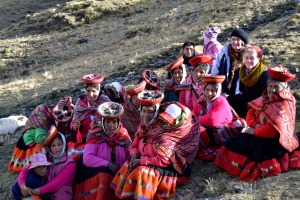 This non-profit organization is making efforts to empower indigenous Andean women whose textiles they purchase at a fair price. Then they offer these products to a global market online. By doing this they are not only helping to sell a traditional good, but also providing an income to the weavers.
This non-profit organization is making efforts to empower indigenous Andean women whose textiles they purchase at a fair price. Then they offer these products to a global market online. By doing this they are not only helping to sell a traditional good, but also providing an income to the weavers.
The importance of the Peruvian handcrafted textiles relies on the ancient tradition it is preserving, as well as the sustainability of the families providing the service. To make these textiles attractive to international buyers, the designs had to overcome some modifications.
That is what Threads of Peru called marketing projects, which aim is to help weavers to fusion some of the world’s modern-fashion tendencies with the ancient Inca designs they produce. That way, a very traditional Peruvian piece becomes sellable to a global market.
Threads of Peru started in a classroom at NSCAD University in Halifax, Nova Scotia, Canada in 2008. The project was created by a class of Interdisciplinary Design students taught by Adam Foster Collins. According to the Threads of Peru website, Collins’ goal was to teach his students that design “is a social process, whose greatest strength lies in drawing out the collective strengths of people working collaboratively across boundaries of culture and discipline.” This class had to reach out to the world and find a place where their skills would help other people. The answer was the Andean weavers in Peru. Ariana Svenson, an Australian woman working in these communities-with sustainable tourism: a project that connects tourists directly with the Andean families-in an agency called APUS Peru, helped these students to make the project a reality.
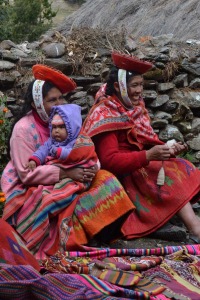 The process working with these women has been long and difficult, and as Svenson said when we met, “It has been much time of hard work, of which the result is not yet clear. But I am sure that the lives of these children are going to change once we change the life of their mothers.”
The process working with these women has been long and difficult, and as Svenson said when we met, “It has been much time of hard work, of which the result is not yet clear. But I am sure that the lives of these children are going to change once we change the life of their mothers.”
When visiting Rumira, one of the communities working with the association, I learned how important weaving is for women all through their lives. It plays an important role in their daily duties as young girls, and later, becomes quite relevant for every important event in their lives since they wear their family history in their clothing. But this beautiful and rich tradition is not helping feed their children and that is the reason why many families have had to leave their communities and try to make a living in overpopulated cities in Peru, where most of the time they face discrimination and exploitation.
Rumira is a prime example of a small Andean village: few families living under very poor conditions, a harsh weather at any altitude—many of them more than 4,000 meters above sea level. Children find it hard to attend to school because of the long distances and even the weather, same happens with medical attention; also in most cases children don’t receive appropriate nutrition.
The textiles weaved in Rumira have been modified by designers, making of them something contemporary and traditional at the same time. The result is a handmade cloth that maintains the Inca weaving tradition, and also offers a very wearable piece for the modern market.
Threads of Peru and the women of the Sacred Valley work every day to improve the lives of the Andean communities. There is no doubt that a change has been made, but the way to go is still long. As for those who would like to contribute don’t doubt visiting the website of this organization (www.threadsofperu.com), you might find the perfect pieces for your autumn and winter wardrobe; and most important, don’t forget what’s behind those beautiful pieces of cloth.



